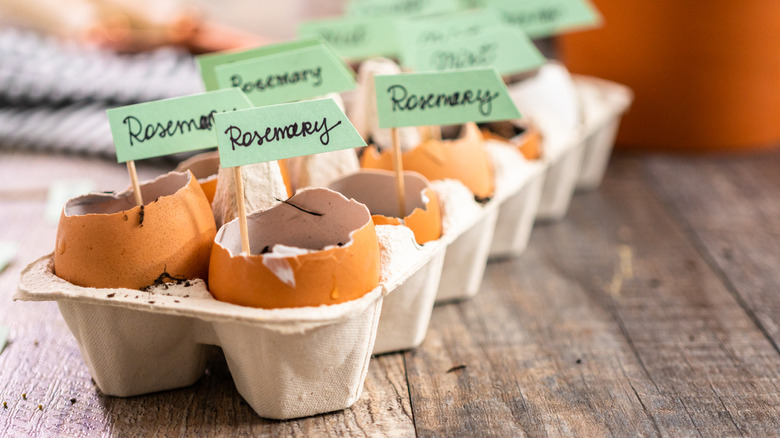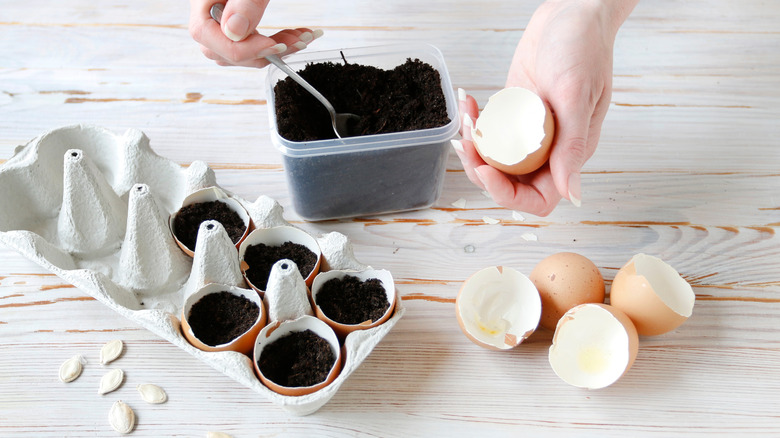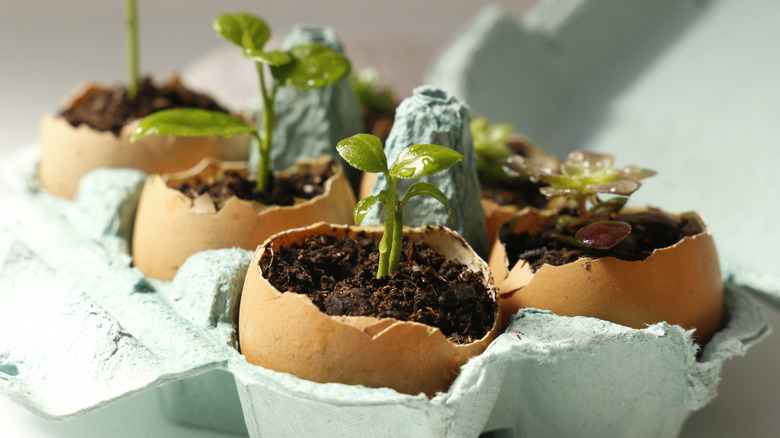How To Use Eggshells As Seed Starters
Not only are eggshells great for fertilizing your plants, but you can also use them to start seeds. Instead of throwing them into the trash after making some scrambled eggs, save them to reuse. Your plants will be thankful. Simply keep an empty egg carton in your kitchen, and every time you crack an egg open, store the shells in this container. Once it's full, you can fill them with soil and seeds.
Choosing eggshells instead of plastic seed starter containers has many benefits. One is that it'll save you money since you're already buying the eggs to eat. It's also better for the planet: you're lowering the amount of garbage coming from your home by finding another use for them, and the shells are biodegradable. Another benefit is that eggshells add nutrients to the soil, releasing calcium, nitrogen, and phosphoric acid as they break down, so your plants grow big and strong. Plus, they help prevent pests like snails because of their sharp edges. Overall, it's better to save your money and reuse your empty eggshells as seed starters using this guide.
Wash the eggshells and then fill them with soil
You must prepare your eggshells before using them as seed starters. First, go through all the shells you've collected to weed out any that aren't large enough. They're still usable if they're unevenly cracked; just choose the piece that is at least halfway intact. Of course, the best option is to change how you open them to keep them relatively intact. When you cook eggs, break a hole into the pointed end instead of breaking the shell in half. That way, there is more room to hold soil and contain your seedling's growing roots.
Now that you have all your shells, clean them to remove any egg residue and bacteria. Fill a pot with water and bring it to a boil. Then toss in the eggs and leave them for a few minutes. The last step before sowing the seeds is creating drainage holes. Don't skip this step, or else your plants will be more susceptible to root rot, since excess water won't have a place to go. Use a needle or small scissors to puncture a hole into the bottom of the shell. Now it's time to plant the seeds. Start by adding water to your seed starting mix before putting it into the shells. Then place your seeds. The amount you add to each eggshell depends on the variety you're growing. Then sprinkle more soil, and your seeds are ready to grow.
Transplant your seedlings
By starting your seeds indoors, you can harvest from them earlier in the season. You just need to find the right spot in your house. Then you can move them outside once the last day of frost has passed. Your eggshells should be near a window with lots of sunlight, and the room should be warm without any cold drafts. Each day, make sure that the soil remains moist. Watering them with a spray bottle makes it easier to deliver the right amount since the eggshells are so tiny.
Soon you'll notice your seeds beginning to sprout. This is the time to cut out any tiny plants that aren't developing as well as the other ones in each eggshell. You may not want to do this, but the shells aren't big enough to support multiple plants. Once they're big enough, it's time to transplant them into pots or your garden. Depending on what you're growing, it may take one to four weeks for them to become seedlings. One way to identify if they're big enough is by looking for a second pair of leaves to develop on the stem. You don't have to take your seedling out of the eggshells to transplant them. Instead, gently crush the shell and remove some of the pieces so the roots can spread out in their new home. Place each one into the new container, deep enough that the shell is covered with soil.


